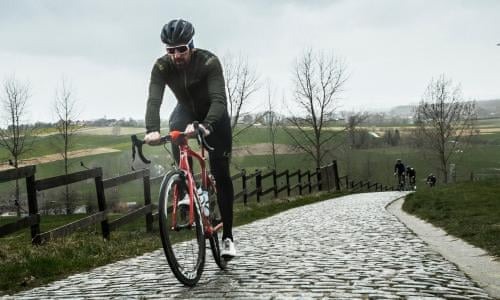
The challenging pavé unsettles this rider, yet Belgium’s cycling heartland offers stunning compensation through its breathtaking scenery.
Belgium’s deep cycling passion extends to fervent worship in Flanders, where dedicated cycle routes intricately weave through the region, marked by clear signage. Entire towns shut down for road races while bike sculptures dot fields and posters of renowned riders adorn streets. Cycling ingrains itself in the local culture, evident in the constant background buzz of chain on cog.
This fervor breeds a type of cyclists known as Flandriens, hailed as some of the toughest globally due to enduring harsh winds and rains sweeping the flat, open landscape during colder months, and their adeptness at navigating the grueling, painful cobbled paths.
Ah, those infamous cobbles! Locally termed pavé, these ancient geometric blocks stand in stark contrast to the smoothness of tarmac, offering an unforgiving ride. Yet, it’s precisely this unyielding hardness that captivates cyclists. These stretches remain iconic in the spring cycle races, notably the nightmarish epics like Paris-Roubaix, predominantly set on Belgian terrain during March and April.
“Next time,” a friend advises, “bring a gumshield to shield your teeth from the relentless shaking,” following grueling hours traversing the pavé, where bikes and bodies seemed on the verge of disintegration. Yet, for me, next time I’ll bypass the cobbles entirely—thankfully, that’s an option. There’s a range of routes available, long or short, bumpy or smooth, in this exceptionally bike-friendly country adorned with extensive bike lanes. For English cyclists accustomed to abrupt curbs, obstructive street fixtures, and irate drivers amidst anti-LTN fervor, these seemingly endless lanes are a dream.
The journey commenced the day prior, rolling off LeShuttle at Calais, a half-hour from Folkestone, then just over two hours to Brakel, a quaint town in southern Flanders strategically situated for the Ronde van Vlaanderen loops. These three circuits—the red, yellow, and blue—spanning between 80km and 115km, meticulously chart out the steepest hills in this otherwise flat terrain, all interspersed with bone-rattling stretches of cobbles.
Our lodging, the Flandrien Hotel in Brakel, caters specifically to cyclists: secure bike storage, ample space and tools for maintenance, laundry amenities, and even a pressure washer. The inclusive high-carb breakfast is abundant, served continuously, while the communal breakfast/bar area showcases a plethora of classic racing bikes, a haven for aficionados to admire and covet.
However, our primary aim was to embrace the bone-rattling encounter with those renowned cobbles, thus our commitment remains unwavering. Day one encompasses the 115km red route featuring the iconic Muur van Geraardsbergen, a fixture in the Tour of Flanders. This narrow, twisting, and uneven cobbled path boasts gradients reaching 20% in certain sections, causing rear wheels to spin frantically, seeking traction on the slick surface. At moments, progress is so sluggish that maintaining balance becomes a challenge, culminating in a final sprint to reach the summit, teetering precariously on the brink of a potential backward somersault.
Fortunately, from this pinnacle, the path descends gently into the rural landscape, winding through fields and small villages along tranquil roads. Day one concludes with us lounging in deck chairs, basking in the late afternoon sun upon our return to the Flandrien Hotel. Not everyone managed the full 115km, but our second day beckons as we prepare to tackle the 102km yellow route.
Commencing and concluding in Oudenaarde at the De Ronde Centre, the hub provides a café, a bike shop, occasional complimentary maintenance, and shower amenities for cyclists. You can safely leave your bikes unattended in the racks and find them intact upon your return from exploring the center’s exhibition on the region’s cycling history. It’s also the spot where you can earn a place on a plaque adorning the wall—simply complete the Flandrien Challenge on Strava, conquering 59 mountain and cobble segments within 72 hours. Plenty of slots were still vacant when I glimpsed at the wall…
The yellow route predominantly revolves around the cobbles—stretches reaching up to 2.5km persistently jolting, causing water bottles to tremble and posing a threat to one’s teeth. It’s akin to gripping a jackhammer rather than handlebars. Yet, when the occasional smooth segments appear, it’s akin to sinking into silky sheets in a boutique hotel after a strenuous day.
On this occasion, the majority of us complete the entire route unscathed, bikes included. However, personally, that’s my fill of cobbles for a lifetime.



